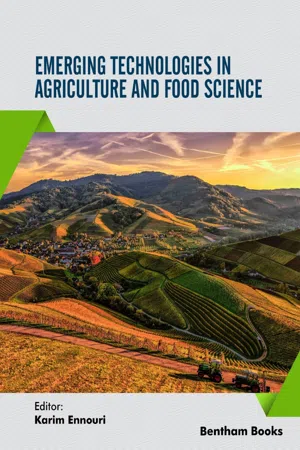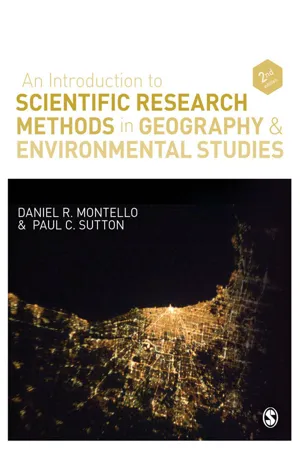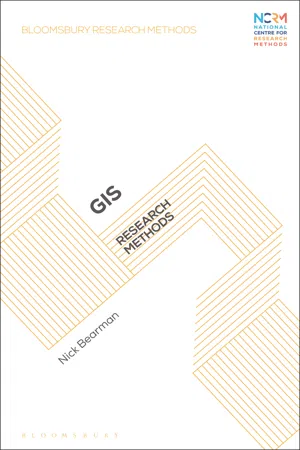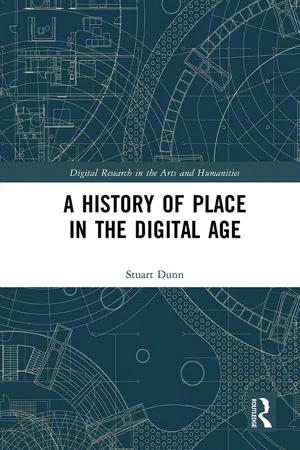Geospatial Technologies
Geospatial technologies refer to tools and techniques used to collect, analyze, and visualize geographic data. These technologies include geographic information systems (GIS), global positioning systems (GPS), remote sensing, and spatial analysis software. They are essential for understanding and solving complex geographical problems, such as mapping natural disasters, urban planning, environmental monitoring, and resource management.
8 Key excerpts on "Geospatial Technologies"
- Prashant K. Srivastava, Prem Chandra Pandey, Pavan Kumar, Akhilesh Singh Raghubanshi, Dawei Han, Prashant K. Srivastava, Prem Chandra Pandey, Pavan Kumar, Akhilesh Singh Raghubanshi, Dawei Han(Authors)
- 2016(Publication Date)
- CRC Press(Publisher)
...The geospatial data sets which generally we gather are suitable for automated analysis in microcomputers. Geospatial Technologies enable scientist to obtain information about a material object, conditions of a geographic space, or an environmental phenomenon, through variety of approaches (Okoye & Koeln 2003). Thus, the geospatial technology are effective tools not only for collection, storage, management and retrieval of a multitude of spatial and non-spatial data, but also for spatial analysis and integration of these data to derive useful outputs and modeling (Gupta & Srivastava 2010; Islam et al. 2012; Srivastava et al. 2013b). Some of the variables used in developing geospatial technology can be retrieved from remote sensing images. However, space borne sensors estimate environmental variables quasiquantitatively and the process of converting and analysing the signals to the actual parameter are often fraught with challenges (Okoye & Koeln 2003). This chapter discusses the importance and value of geospatial technology and points out the weaknesses which are needed to be resolved in near future. It will also focus on some limitations and drawbacks of geospatial technology that researchers, policy makers and practitioners should be taken care with in order to view the technology in a proper perspective. COMMON CHALLENGES IN REMOTE SENSING FOR WATER RESOURCES Day-by-day the Earth remote sensing data retrieval, processing, distribution and application becomes more challenging and hence desires a more detailed scrutiny on a regular basis. Huge volumes of remote sensing data will be produced as the number of earth observing satellites are increasing day by day and there are many more coming in the near future (Srivastava et al. 2014d). Classical data processing and distribution methods generally suffer from poor performances and thus make them inadmissible for numerous end users and real time forecasting which require high performance spatial datasets (Dai et al...
- eBook - ePub
- Catherine Dawson(Author)
- 2019(Publication Date)
- Routledge(Publisher)
...CHAPTER 21 Geospatial analysis Overview Geospatial analysis is the process of gathering, exploring, manipulating, analysing and visualising data that contain explicit geographic positioning information or reference to a specific place. This can include Global Positioning System (GPS) data, satellite imagery, photographs, geographic information system (GIS) maps and graphic displays, airplane and drone imagery, remote sensing and historical data, for example. Geospatial analysis is related closely to spatial analysis: indeed, the terms are sometimes used interchangeably (see some of the software packages listed below for examples). However, ‘geospatial’ relates to data that contains a specific geographic component (locational information) whereas ‘spatial’ relates to the position, area, shape and size of places, spaces, features, objects or phenomena. More information about spatial analysis and spatial modelling (the analytical process of representing spatial data) can be found in Chapter 54. The use of geospatial analysis is increasing across a number of disciplines and fields of study including geographical sciences, environmental sciences, archaeology, history, health and medicine, criminal justice and public safety, business, transportation and logistics, urban planning, education and international development...
- Karim Ennouri(Author)
- 2020(Publication Date)
- Bentham Science Publishers(Publisher)
...Geographic Information Systems have the ability to examine soil records and conclude which plants should be planted where and how to sustain ground nutrition so that the plants are best advantaged [ 15 ]. It assists cultivators to reach higher productions and lower costs through enabling better management of land resources. Agricultural Geographic Information Systems using Geomatics Technology facilitate the farmers to plan and forecast current and future fluctuations in rainfall, temperature, and yield. REMOTE SENSING AND GEOGRAPHICAL INFORMATION SYSTEM: GENERALITIES Remote sensing, as an instrument and technique, has developed traditional similarity with other scientific development, for example, the enhancement in an optical lens, electronic detectors and sensors, satellite interfaces, communication structures and the computational processing of recorded data. In the 20 th century, the best progress in airborne exploration and picture elucidation was established by the armed forces during the two World Wars [ 16 ], and more recently, this novelty was made accessible to the civil residents, leading to its initial appliance in the natural resource supervisions. In the sixties, the National Aeronautics Space Administration started the Television and Infrared Observation Satellite (TIROS-1), which permitted the greatest comprehension of atmospheric circumstances. The expression “remote sensing” was initially employed in the sixties to express any types of monitoring globe from space and launching numerical equipments with the National Aeronautics Space Administration [ 5 ]. The recent history of remote sensing of the globe via satellite commenced while the Landsat Multispectral Scanner System (MSS) supplied firstly at the beginning of seventies. The Multispectral Scanner System is constituted by multi-spectral bands (4 bands) through sensibly available high spatial resolution (80 m), extensive region (185 × 185 km), and replicating exposure (each 18 days) [ 17, 18 ]...
- Daniel Montello, Paul Sutton(Authors)
- 2012(Publication Date)
- SAGE Publications Ltd(Publisher)
...13 INFORMATION TECHNOLOGIES IN RESEARCH LEARNING OBJECTIVES What is geographic information, what forms does it come in, and what are some ways it is used in research? What are some important considerations when analyzing, mapping, and interpreting geographic information? What is remotely sensed imagery, and what are some ways it is used in geographic and environmental research? What are the major analytic capabilities of geographic information systems (GIS)? The increased availability and sophistication of computers in the last several decades has enabled the development of digital software and hardware systems specialized for storing, updating, analyzing, displaying, and communicating geographic information. 1 Geographic information is information about the earth and earth environments; it includes geodetic information about the earth (Chapter 5), as well as information about the biophysical and human structures and processes occurring there. This information is spatially referenced – it includes location and other spatial properties, such as size, connectivity, and so on. Historically, geographic information was limited to verbal descriptions and cartographic maps. Today, geographic information is stored digitally in simple and complex data structures on computer readable media. The abstraction of earth-surface reality to these digital data structures both limits and extends our understanding of geographic and environmental processes and phenomena. Remotely sensed imagery from satellites and aerial photographs provide a significant subset of geographic information used by researchers, whether they focus on biophysical or human phenomena...
- eBook - ePub
Geospatial Intelligence
Origins and Evolution
- Robert M. Clark(Author)
- 2020(Publication Date)
- Georgetown University Press(Publisher)
...It has made significant strides since its debut in the 1960s, and now has become the essential technology for producing geospatial intelligence. It is one of several tools that fall within the realm of geomatics. Geomatics The term geomatics has its origin in the disciplines of geodesy and photogrammetry. Michel Paradis, a photogrammetrist working in the Ministry of Natural Resources in the Quebec Provincial Government, is credited with originating the term géomatique (English: geomatics) in a 1981 paper. He wasn’t the first to use the term, but he gave it a broad scope. Paradis attached to it the vision of a unifying construct for the many tools, methods, and technologies associated with geospatial knowledge. Those include methods of Earth mapping, land surveying, remote sensing, cartography, GIS, global navigation satellite systems, photogrammetry, geophysics, and geography. And most importantly, it includes the synergy among them. 5 The most general definition of geomatics, according to Science magazine, is “the science and technology of collecting, manipulating, presenting, and using spatial and geographic data (notably data pertaining to Earth) in digital form.” 6 Since its introduction by Paradis, geomatics has become a unifying construct that incorporates the collection systems that have been covered in chapters 10 through 12, the geographical information systems discussed in chapter 6, and much more. It is now a distinct educational discipline taught in many universities worldwide. The term is clearly connected to geospatial intelligence, but with an emphasis on the tools and techniques for acquiring and handling geospatial data; GEOINT, of course, emphasizes more of the analysis side. Two important geomatics tools are the ones for dealing with big data and visual analytics, and both are tied to GIS. Geographic Information System GIS, introduced in chapter 6, is a ubiquitous acronym today. Yet when asked exactly what it means, blank stares can be the result...
- Elisabete A. Silva, Patsy Healey, Neil Harris, Pieter Van den Broeck, Elisabete A. Silva, Patsy Healey, Neil Harris, Pieter Van den Broeck(Authors)
- 2014(Publication Date)
- Routledge(Publisher)
...4.8 Geoprocessing and Spatial Planning Some concepts and applications Jorge Xavier da Silva, Tiago Badre Marino and Maria Hilde de Barros Goes DOI: 10.4324/9781315851884-36 Introduction The recent development of geotechnologies has brought many advances to environmental studies. Geoprocessing techniques have increasingly being used in rural and urban planning and management as an integrative procedure dealing directly and simultaneously with both the spatial and the taxonomic research dimensions. They contribute to the creation of reasonable theoretical and practical assemblages, not only of data but also of knowledge concerning environmental problems. Although centred in geoprocessing and in previous works developed by the authors, this chapter discusses concepts, methods and techniques applied to varied research fields which deal with spatial data generation and analysis, such as digital cartography, global positioning systems (GPS), remote sensing and, hopefully, spatial planning. This chapter begins by illustrating why there is a growing interest in environmental research in the “geo” procedures and problems (Xavier-da-Silva and Marino, 2010, 2011). In a second stage, we clarify several terms, such as geodiversity (Xavier-da-Silva et al., 2001, p. 304), an expression described as a representation of the variability of environmental characteristics; geotopology (Xavier-da-Silva and Zaidan, 2007, p. 20), which considers proximities and types of dispersion; and geoinclusion (Xavier-da-Silva and Marino, 2011), which may refer, for example, to the insertion of data about the population and its activities into their geographical – physical, biotic and socio-economic – context...
- eBook - ePub
GIS
Research Methods
- Nick Bearman(Author)
- 2020(Publication Date)
- Bloomsbury Academic(Publisher)
...In 1997, the long-running journal International Journal of Geographical Information Systems changed its name to International Journal of Geographical Information Science to better reflect the changes in the academic discipline (Yuan, 2017). GIS has evolved over time, with the barrier to entry (in terms of computer power and technical skill) becoming progressively lower. The launch of Google Earth and Google Maps revolutionized GIS, including explaining what we do to our parents and grandparents (‘it’s like Google Earth, but you can edit and customize the data, and do analysis’). It also pushed software providers to make their programs much easier to use, which benefits everyone. The history is explored further in Chapter 2. What is social science? Now we know what GIS is, how do we apply this in social science? I am being fairly broad in my definition of social science, including anthropology, communication studies, economics, education, history, law, linguistics, political science, psychology, sociology as well as many other areas. Of course, geography is also a key part of social science, but many geographers know GIS already, so if you know GIS already this book is not for you. However, if you are a geographer and want to learn more about GIS, please read on! Geospatial data is vital in all of these areas and GIS can be applied across them all. For example, economists might look at how people’s spending power varies, either at a global scale (‘Big Mac Index,’ 2019 ; such as the Big Mac index, ‘The Big Mac index’, 2019) or within a town or city. In linguistics we might look at how language varies across the world or how it has moved across space and time (Luebbering, 2013). In literature, we might create some very nice maps of fictional worlds, such as the Lord of the Rings or Westeros (Game of Thrones)...
- eBook - ePub
- Stuart Dunn(Author)
- 2019(Publication Date)
- Routledge(Publisher)
...As will be seen below, it is also a key tool for spatial research in the humanities. The role of the GeoWeb as an agent of spatial literacy and a tool(set) of the spatial humanities is complicated by its human and technical history. Like the Internet and WWW of which it is part, the GeoWeb has no single designer, or even a single set of design principles. It is partly a product of the development of mobile technology which enables users to contribute data to it as ‘voluntary sensors’ (Goodchild, 2007) as well as consuming it; of GPS systems which allow the data thus created to be georeferenced in real time (Junglas & Watson, 2013); of the communication infrastructures that give the real-time mobile device coverage that enables georeferencing (Hill, 2009); the applications that enable users to use spatial data, and the standards which underpin those applications. But most importantly of all, it is defined by the very visible presence of a set of large, monolithic web mapping platforms such as OpenStreetMap (OSM), Google Earth, Bing Maps and Yahoo Maps, which emerged as the use of geospatial media gained wide uptake and usage. These, more than anything, embody the public face of what the GeoWeb is today, and have come to guide large swathes of WWW usage, sometimes obviously, sometimes not. These platforms also frame numerous debates between the merits of Open Source software (like OSM), and proprietary applications (like Google Maps)...







